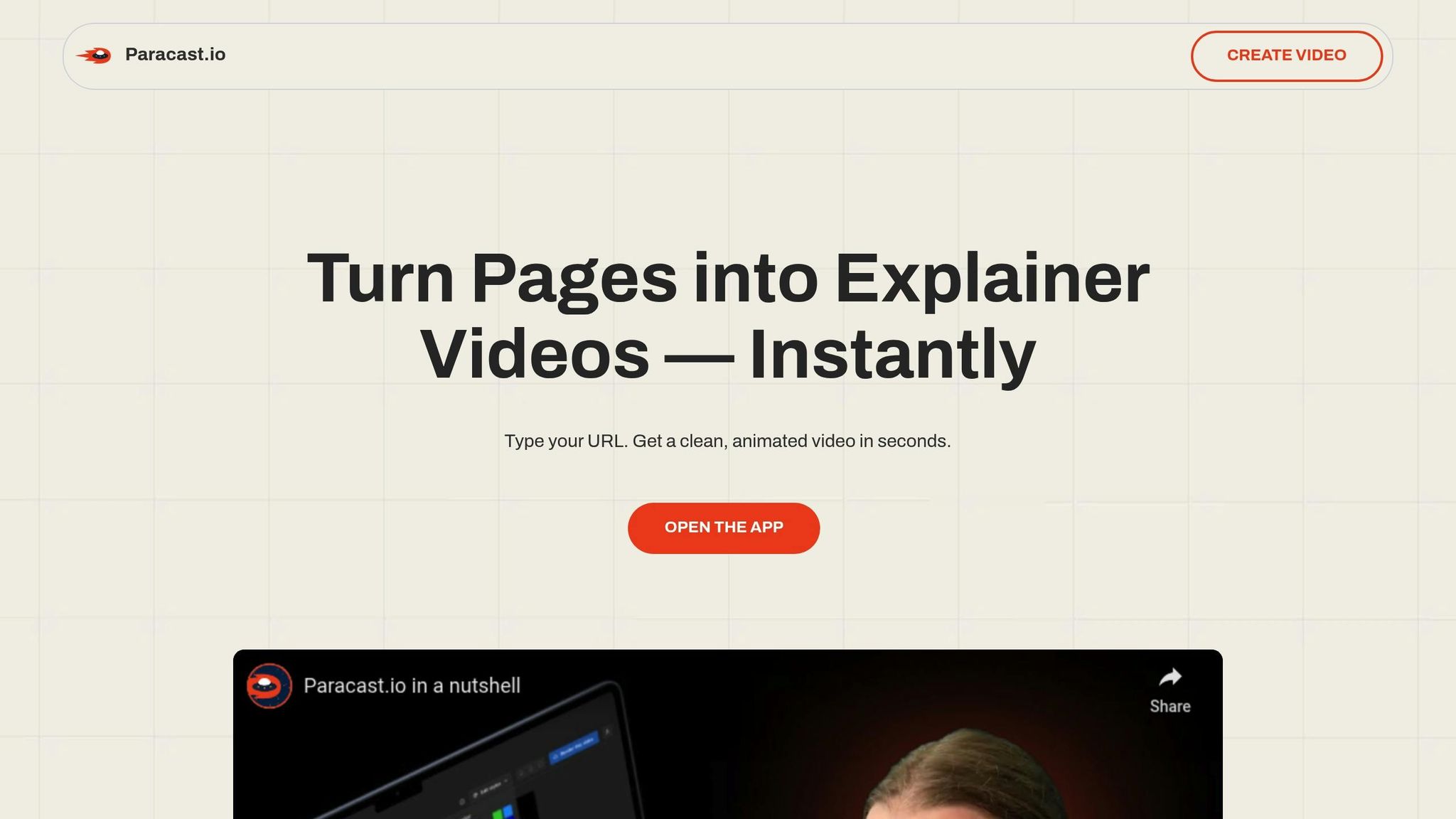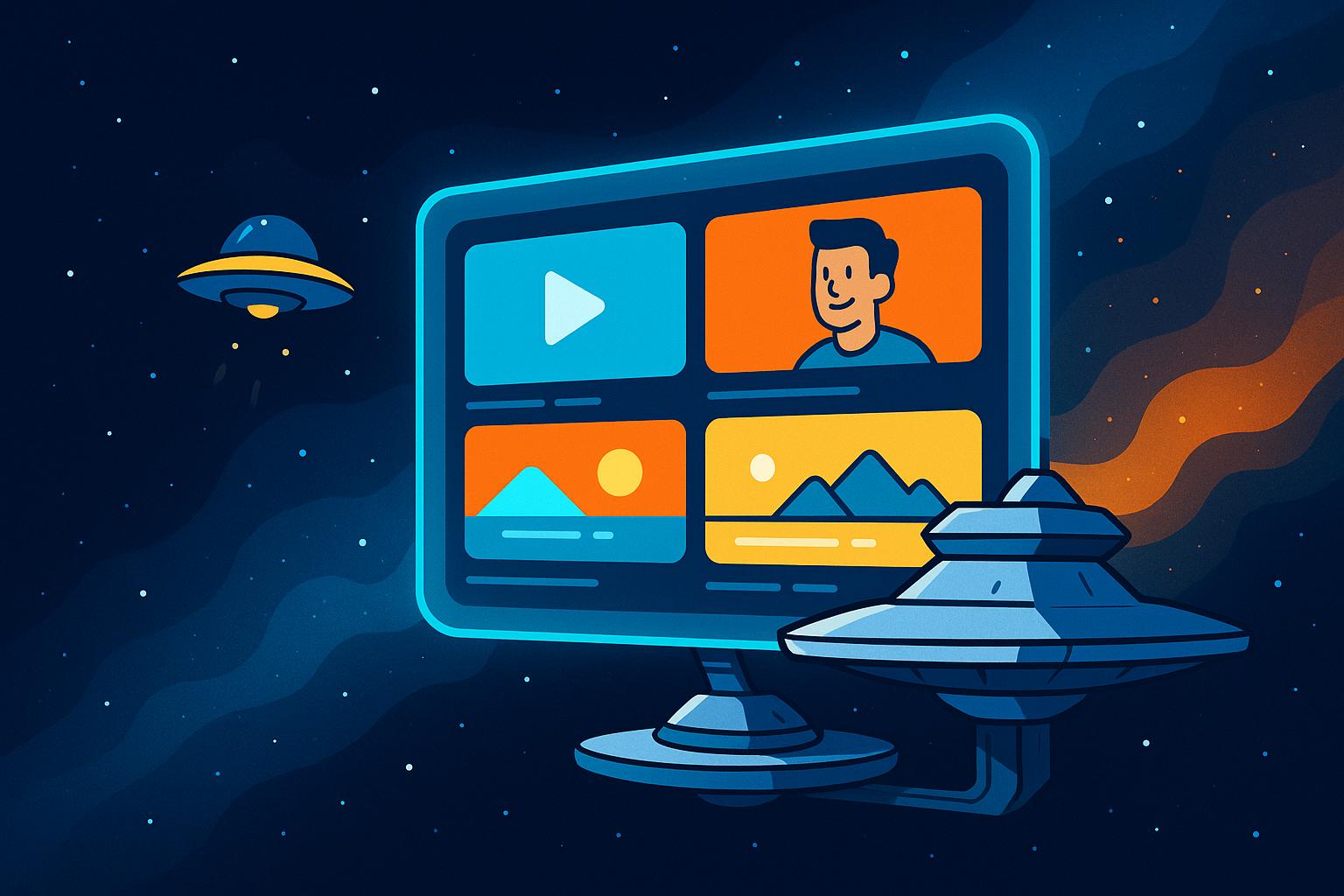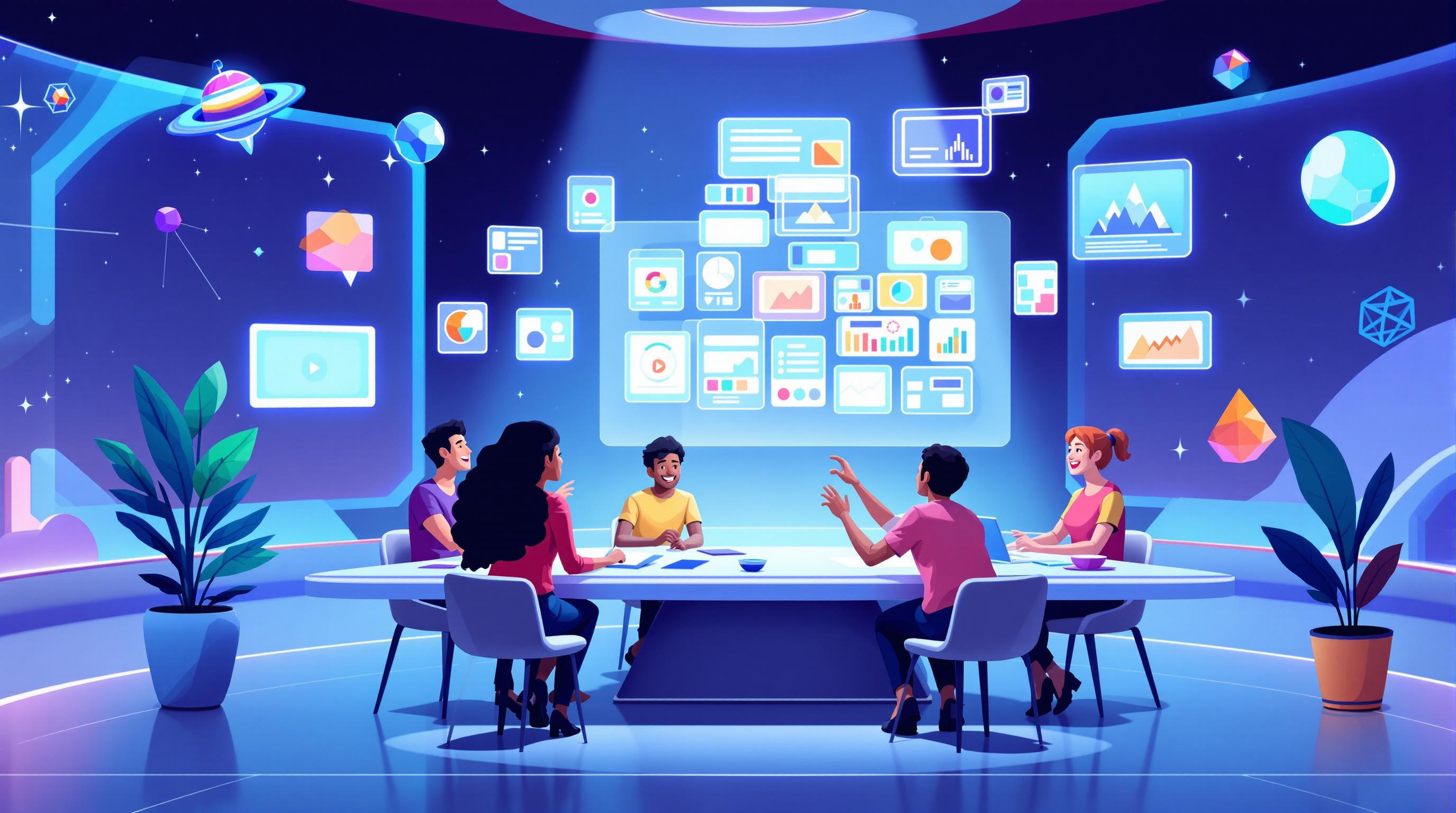AI is transforming video marketing by revealing how viewers interact with content. Here’s what you need to know:
- Why it matters: Videos improve message retention by 95% and can boost conversions by over 80%. But marketers struggle to understand viewer behavior.
- What AI does: AI analyzes viewer actions like watch time, drop-offs, replays, and engagement (likes, shares, comments). It predicts trends and delivers insights to improve content.
- Key results: Companies using AI see a 20–50% increase in engagement and a 20% boost in ROI.
- How it helps: AI tools simplify analysis, provide real-time feedback, and personalize content to keep viewers engaged.
AI-powered insights let marketers optimize videos, personalize experiences, and improve results with actionable data.
How to Track Content Performance With AI
Key Viewer Behavior Metrics Tracked by AI
AI delves deeper than simple view counts, tracking detailed viewer interactions to fine-tune video marketing campaigns and improve outcomes. Let's explore the key metrics that make such precision possible.
Watch Time and Completion Rates
Watch time measures how long viewers stay engaged with your video, offering insights into which parts resonate most. AI can identify both the strongest segments and points where viewers lose interest, making it a much better indicator of performance than just counting views.
Similarly, completion rates track the percentage of viewers who watch your video all the way through. This metric is essential for gauging whether your content keeps attention from start to finish. For example, a leading sports broadcaster uses AI to analyze live streaming data, monitoring viewer engagement in real time. This allows them to adjust broadcasts on the fly, creating a more engaging experience.
Engagement Actions
AI monitors likes, shares, comments, and click-through rates to evaluate how well your videos inspire audience interaction. Among these, comments and shares often reveal more about a video's viral potential than likes. By analyzing these actions, AI uncovers the elements that spark emotional connections. For instance, a retail company used AI to refine its Facebook ads. By identifying the most responsive audience segments and retargeting engaged viewers, they were able to increase conversions significantly.
Drop-Off Points and Scene Performance
One of AI's standout capabilities is drop-off analysis, which pinpoints the exact moments viewers lose interest. This insight helps marketers identify scenes that might need reworking.
AI also generates heatmaps to highlight the most engaging scenes and track where viewers drop off. Additionally, re-watch data can reveal which parts of a video were particularly compelling - or perhaps confusing. For example, a tech company improved its YouTube ad performance by analyzing optimal ad lengths and refining its messaging, leading to higher completion rates and better audience engagement.
Demographic and Behavioral Insights
AI goes beyond basic audience data, analyzing demographics like age, location, and interests, while also building detailed profiles based on viewing habits and engagement patterns.
For B2B marketers, this level of insight is invaluable. With 66% of B2B buyers expecting personalized content during their purchasing journey, AI makes targeted campaigns possible. In one example, an e-commerce brand used behavioral analysis from video data to improve its Google Ads click-through rates, resulting in better conversions and more customers. These insights help refine content and guide audience segmentation strategies.
"AI helps you create winning content from the very beginning...to find the video lengths, content formats, and scene structures that your audiences like and want." - Silvi Dua
Together, these metrics deliver a full picture of video performance. Marketers leveraging AI-powered analytics have reported engagement increases of 20–50%, showcasing the real-world impact of detailed viewer behavior analysis.
How AI Analyzes and Interprets Viewer Data
AI has revolutionized the way marketers understand and act on viewer data. By transforming raw information into insights, advanced algorithms provide a clearer picture of audience behavior, helping marketers make smarter decisions.
Machine Learning and Pattern Recognition
AI systems rely on machine learning algorithms to dig through historical data, uncover patterns, and predict behaviors that would otherwise go unnoticed. These algorithms are trained on massive datasets, allowing them to identify trends and forecast future viewer actions with impressive precision.
But AI doesn’t stop at tracking clicks. It dives deeper by analyzing visual cues and audience feedback to create detailed profiles of engagement behavior. Using neural networks for deep learning, AI processes complex visual data, while computer vision interprets video inputs.
One standout application of this technology is audience segmentation. By analyzing engagement patterns, AI helps marketers tailor content recommendations and advertising strategies. For instance, a global streaming service uses AI to study viewing habits and preferences, delivering personalized recommendations to subscribers. This approach has boosted viewer retention and improved the overall user experience.
AI's ability to predict future behavior is a game-changer for content creators. By identifying trends in engagement and preferences, it allows marketers to anticipate audience needs. For example, an online education platform leverages AI to track student interactions with videos. By studying attention spans and engagement levels, the platform refines its content and creates customized learning paths.
These capabilities enable real-time adjustments and more precise predictive analytics.
Real-Time Monitoring and Predictive Analytics
Real-time monitoring provides instant insights into audience behavior, enabling marketers to adapt strategies on the fly. During live broadcasts, AI tracks metrics like view counts, watch time, and interaction rates in real time.
AI also excels at sentiment analysis, helping broadcasters gauge audience reactions through comments and feedback. For example, AI can analyze facial expressions (with consent) to assess emotional responses or use heatmaps to determine where viewers focus their attention during live events.
A major sports broadcaster uses this technology to enhance live-streaming experiences. By monitoring viewer reactions, the network adjusts camera angles or commentary in real time, creating a more engaging broadcast. This data also helps optimize ad placement, improving revenue and delivering better ROI for advertisers.
"AI doesn't just analyze current engagement levels; it can also predict future behaviors based on historical data. Machine learning algorithms can identify patterns in viewer preferences and engagement trends, helping content creators to anticipate what their audience might want to see next." - Digital Tools Mentor
Businesses that embrace real-time data monitoring often see a 20% boost in marketing ROI. AI can even adapt stream quality on the spot, ensuring smooth playback across different devices and internet speeds.
These insights feed into automated systems that make reporting and decision-making faster and easier.
Automated Reports for Actionable Insights
AI doesn’t just collect data - it turns it into actionable reports. By automating the analysis process, AI simplifies complex datasets into clear insights that marketers can use without needing technical expertise. These reports highlight patterns and trends that might otherwise go unnoticed, helping shape future campaigns.
Take Netflix and Amazon Prime Video, for example. Both platforms use AI to enhance their recommendation engines, personalizing content suggestions and retaining subscribers while optimizing original content production. Coca-Cola also harnessed AI to create thousands of personalized video ads tailored to individual viewer preferences, from favorite music genres to sports teams. This approach led to higher engagement and better ad performance.
AI-powered tools also help marketers fine-tune content and improve audience interaction. A multinational retail company, for instance, uses AI to analyze how customers engage with in-store digital displays. By studying interactions with video ads, they optimize marketing strategies and create more personalized shopping experiences.
The impact of AI spans industries. By late 2023, 80% of movie, TV, and animation companies in the US were using generative AI in their production processes. Digital marketing agencies rely on AI to analyze video campaign performance across platforms, refining strategies based on what resonates most with audiences.
"There is a saying going around now - and it is very true - that your job will not be taken by AI. It will be taken by a person who knows how to use AI. So, it is very important for marketers to know how to use AI." - Christina Inge, Instructor at the Harvard Division of Continuing Education's Professional & Executive Development
Using AI Insights to Optimize Video Marketing
AI insights are a game-changer for video marketing, offering tools to refine content, personalize viewer experiences, and maximize ROI. These insights empower marketers to make data-driven decisions that enhance every aspect of their video campaigns.
Content Optimization Through Data Insights
AI helps marketers fine-tune their video content by analyzing how viewers respond to messaging, visuals, and timing. For example, YouTube's recommendation algorithm leverages user behavior, preferences, and search history to suggest videos tailored to individual tastes. Similarly, TikTok's algorithm monitors likes, shares, and skips to curate a personalized feed.
These insights also guide marketers in improving video metadata, such as titles, descriptions, and tags, to boost SEO and visibility. By identifying the keywords and phrases that drive engagement, marketers can craft metadata that draws the right audience to their videos.
AI doesn't stop there. It can determine the optimal video length, tone, and release timing based on audience preferences. Maxime Bouillon, Co-founder & CEO at Archie, highlights the value of real-time analysis:
"AI-driven algorithms can analyze viewer engagement in real-time, adjusting content to reflect audience preferences like optimal video length, tone, and timing...This real-time analysis helps refine video content to boost engagement while minimizing wasted spend on underperforming material".
Additionally, AI can predict emerging trends, enabling creators to produce timely videos that resonate with viewers before trends fade. This forward-thinking approach ensures content remains fresh and relevant, setting the stage for deeply personalized video experiences.
Personalized Video Experiences
Once content is optimized, AI takes personalization to the next level by tailoring videos to individual viewer interests. Unlike basic demographic targeting, AI enables hyper-personalization by analyzing data such as preferences, viewing habits, and previous purchases.
A great example of this is Netflix, which customizes video trailers based on a user's viewing history. Instead of serving the same trailer to everyone, Netflix uses AI to highlight scenes that match each viewer's unique tastes.
Real-time data makes this personalization even more dynamic. AI can adapt video content on the fly, altering calls-to-action or shifting focus to keep viewers engaged. This responsiveness creates a more immersive experience for the audience.
To make personalization work at scale, storytelling remains key. Engaging narratives help connect with viewers, while AI ensures these efforts can be applied across large audiences. Regular testing and optimization are essential, as is compliance with data privacy regulations.
Campaign Adjustments and ROI Maximization
AI insights allow marketers to continuously refine their campaigns, delivering measurable results. For instance, AI-driven video analytics have been linked to a 20–50% increase in engagement metrics, while personalized video content generates three times more conversions than non-personalized alternatives.
The ability to make real-time campaign adjustments is where AI truly excels. Julian Lloyd Jones from Casual Outfitters explains:
"AI helps brands tweak campaigns on the fly, analyzing live data to segment audiences better and personalize content. This real-time responsiveness is key to boosting engagement and keeping content relevant for your audience".
The results can be transformative. Sumeer Kaur, Founder of Saree, shares:
"AI algorithms can detect real-time engagement shifts, allowing marketers to adjust future videos to amplify the parts that hold the audience's attention longer. This has led to a reported 40% increase in completion rates for some brands".
AI also powers automated A/B testing, helping marketers identify what works best, and enables interactive video features like clickable overlays, quizzes, and "add-to-cart" options . These features not only boost engagement but also provide valuable data for further optimization.
With accurate, real-time performance insights, marketers can anticipate audience reactions and refine their approach before launching content. This creates a feedback loop where each campaign benefits from the lessons of the last.
"AI is reshaping how brands create, optimize, and distribute video content - ensuring every video hits the right audience, at the right time, with the right message." - Business Marketing Engine
sbb-itb-5bfa442
AI Tools for Video Behavior Analysis
The world of video analytics has undergone a massive shift, thanks to AI-powered platforms that dig deeper than simple view counts. These tools provide marketers with detailed insights into how audiences interact with video content, offering a new level of understanding.
Overview of AI-Driven Video Analytics Platforms
Today's AI-driven video analytics platforms use machine learning to break down visual, audio, and structural elements in real time. Some boast impressive results, such as achieving up to 94% accuracy in summarization and 89% in identifying key topics.
These platforms can do much more than count views. They detect objects, recognize faces, and analyze expressions, body language, gaze direction, and even tone of voice to measure viewer emotions and engagement [35,5]. Unlike traditional manual analysis, which can take hours or even days, AI processes this data almost instantaneously.
Top-tier platforms offer features like real-time content recognition, sentiment tracking with up to 92% accuracy, frame-by-frame analysis, and detailed demographic breakdowns. Some advanced systems even include anomaly detection, multi-camera analytics for a more complete understanding of events, and behavioral analysis to predict how viewers might act in the future.
Case studies highlight the impact of these tools: companies have reported a 45% boost in content engagement, a 30% improvement in audience targeting accuracy, and reduced production costs - all within just a few months of adopting AI-driven analytics. These capabilities not only analyze viewer behavior but also pave the way for creating more engaging video content.
How Paracast.io Simplifies Video Marketing

Building on the power of AI analytics, Paracast.io takes things a step further by helping marketers turn insights into action. This platform uses AI to transform website URLs into professional promotional videos, complete with pre-designed templates for demos, announcements, milestones, and social campaigns.
By analyzing the content of a website, Paracast.io's AI generates videos specifically designed to keep viewers engaged. It’s a game-changer for small teams, allowing them to produce high-quality promotional videos without needing specialized production skills. Marketers can test different messaging strategies and figure out what resonates most with their audience, all while leveraging personalization and campaign optimization insights.
For teams looking to scale their efforts, Paracast.io offers unlimited video creation, 1080p quality, and customizable branding. Its straightforward editing interface makes it easy to iterate on video content based on performance data. The platform’s Pro plan, priced at $80/month, removes watermarks and unlocks unlimited access to templates, making it a budget-friendly option for producing multiple video variations for A/B testing or audience segmentation strategies.
Best Practices for Using AI in Video Marketing
To get the most out of AI in video marketing, it's essential to follow proven practices that enhance results while staying compliant and continuously improving. These steps ensure your efforts are effective, accurate, and respectful of user privacy.
Prioritize Data Privacy and Compliance
Protecting user privacy isn't just a legal requirement - it builds trust with your audience. If you're using AI to analyze viewer behavior, make sure to get clear consent before collecting any data. Update your privacy policies to explain exactly how you'll use this information.
Here’s why this matters: In 2022, Sephora faced a $1.2 million fine for failing to comply with privacy laws, leading to stricter compliance measures. To avoid similar issues, implement tools like a Tag Management System (TMS) to manage opt-in/opt-out options for third-party codes. Pair this with a Consent Management Platform (CMP) to give users clear choices about their data. Together, these systems ensure users’ privacy preferences are automatically respected.
Regularly scan your website to identify trackers and block any that collect personal data without consent. Keep your privacy notices up-to-date to reflect new technologies or changes in how you use data.
If you're handling sensitive information like health-related data, exercise extra caution. For example, Washington's My Health My Data Act imposes strict regulations on businesses processing health data, which is defined more broadly than you might expect.
Use Clear, Standardized Reporting Formats
Confusing or inconsistent reports can slow down decision-making. Standardized templates solve this problem by creating clarity and consistency. AI tools can help by spotting inconsistencies and applying pre-set formats automatically.
A good reporting template should include:
- A clear title and date
- An executive summary
- Key performance indicators (KPIs) with visual aids like charts
- An analysis section
- Supporting data in an appendix
The benefits of standardization are clear. For instance, a global logistics company reduced reporting time by 40% and boosted confidence in their data by 25% after adopting AI-driven reporting templates. If you're working in the U.S., ensure your reports follow local conventions, such as MM/DD/YYYY for dates, dollars ($) for currency, and imperial measurements when relevant.
Start by standardizing your most critical reports, then expand the process to other areas. A dedicated reporting governance team can oversee this effort, ensuring consistency across all analytics. Once your reports are streamlined, use the insights to refine your video marketing strategies.
Iterate and Improve Based on Insights
AI insights are only useful if you act on them. The best video marketers treat analytics as an ongoing process, constantly reviewing data and adjusting their strategies to improve results.
Focus on key metrics like view count, engagement rates, conversion rates, and viewer retention. When patterns emerge, test new approaches. For example, if AI shows viewers dropping off at specific points in your video, try restructuring the content, adding interactive elements like polls, or tweaking your call-to-action timing.
Research supports this approach: YouTube ads placed during high-engagement moments have achieved up to a 30% higher completion rate, with ad watch time increasing by 25% when mid-roll ads are placed strategically.
Start small and track the results. Experiment with video lengths, thumbnails, pacing, and formats. Use A/B testing to compare outcomes, and don’t hesitate to cut content that isn’t performing well. Optimization is a continuous journey - viewer preferences and platform algorithms change, so your strategy should too.
Conclusion
AI is revolutionizing how marketers analyze and improve video content. By offering deep insights into viewer behavior - like when audiences engage, lose interest, or take action - it provides a roadmap for creating more effective campaigns. These insights lead to actionable strategies that drive measurable results.
Key Takeaways for Marketers
Marketers using AI-powered video analytics have seen engagement rates jump by 20–50%. Even more impressive, personalized video content driven by analytics achieves three times the conversion rates of non-personalized videos. These advantages give businesses a competitive edge in a crowded digital landscape.
Some of the biggest names in the industry are already reaping the benefits. For example, Nike used AI to craft personalized video ads tailored to user activity patterns, leading to a 30% boost in engagement and record-breaking conversion rates. Similarly, Starbucks harnessed AI to analyze consumer behavior and deliver customized video promotions, resulting in a 21% increase in redemption rates.
"Marketing is no longer about the stuff that you make but the stories you tell." – Seth Godin
AI doesn’t replace creativity - it amplifies it. To get the most out of AI tools, start with clear goals. Whether you’re aiming to increase watch time, improve brand recall, or drive conversions, define success from the outset. Treat video optimization as an ongoing process, using AI insights to refine your strategy at every step.
The numbers speak for themselves: 74% of organizations using generative AI report a positive return on investment, and AI-powered customer acquisition tactics have been shown to boost conversion rates by up to 30%. The real challenge isn’t whether AI will transform video marketing - it’s how quickly your team can adapt to stay ahead.
Using Tools Like Paracast.io
For many marketers, the key to success lies in finding practical, accessible tools that integrate AI seamlessly into their workflow. That’s where platforms like Paracast.io shine.
Paracast.io simplifies video creation by using AI to generate promotional videos directly from website URLs. With pre-designed templates for social media campaigns, product demos, announcements, and more, teams can create professional-grade videos in just minutes.
This platform can cut production time and costs by as much as 80%. For small teams managing multiple priorities, this efficiency is game-changing. Instead of getting bogged down by technical production tasks, marketers can focus on strategy and optimization.
What sets tools like Paracast.io apart is their ability to combine AI insights with practical execution. The platform’s templates are built around proven engagement patterns, giving your videos a strong starting point. From there, you can use behavioral data collected during your campaigns to fine-tune your content for maximum impact.
The future of video marketing belongs to agile teams that can test, learn, and adapt quickly. With tools like Paracast.io, AI-driven video marketing becomes accessible to businesses of all sizes, leveling the playing field and opening the door to new opportunities.
FAQs
How does AI analyze engagement metrics like likes, shares, and comments, and why are they important for video marketing?
AI dives deep into engagement metrics like likes, shares, and comments by not just counting interactions but also analyzing their quality. It identifies patterns in user behavior, deciphers the tone and sentiment behind comments using natural language processing, and even uses advanced tools like facial recognition or eye-tracking to gauge emotional reactions.
These insights are a game-changer for video marketing. They reveal what truly connects with your audience, helping marketers tweak their strategies to enhance engagement, keep viewers satisfied, and achieve stronger results over time.
How does AI adjust video content in real-time to keep viewers engaged?
AI takes viewer retention and engagement to the next level by analyzing real-time behavior - like when someone pauses, skips, or stops watching a video. Using this data, it can make smart adjustments, such as trimming scenes automatically, rearranging segments, or spotlighting essential moments to better match what the audience wants.
On top of that, AI can spot engagement trends to deliver content more effectively. For instance, it might shorten scenes for viewers who tend to lose focus quickly or emphasize specific elements for those who pay closer attention. These instant tweaks help videos stay engaging and relevant, cutting down on drop-off rates and encouraging more interaction overall.
How can businesses use AI in video marketing while respecting user privacy and following data protection laws?
To integrate AI into video marketing responsibly, businesses need to put user privacy front and center. This starts with obtaining clear consent before gathering any personal data, ensuring compliance with regulations like GDPR and U.S. data protection laws.
Companies should also embrace practices like data minimization, which means only collecting the information that’s absolutely necessary. Being upfront about how data will be used is equally important to maintain transparency. On top of that, implementing strong encryption methods and scheduling regular compliance audits can go a long way in protecting user information. By sticking to these practices, businesses can build trust while keeping their AI-powered video marketing both ethical and legally sound.


